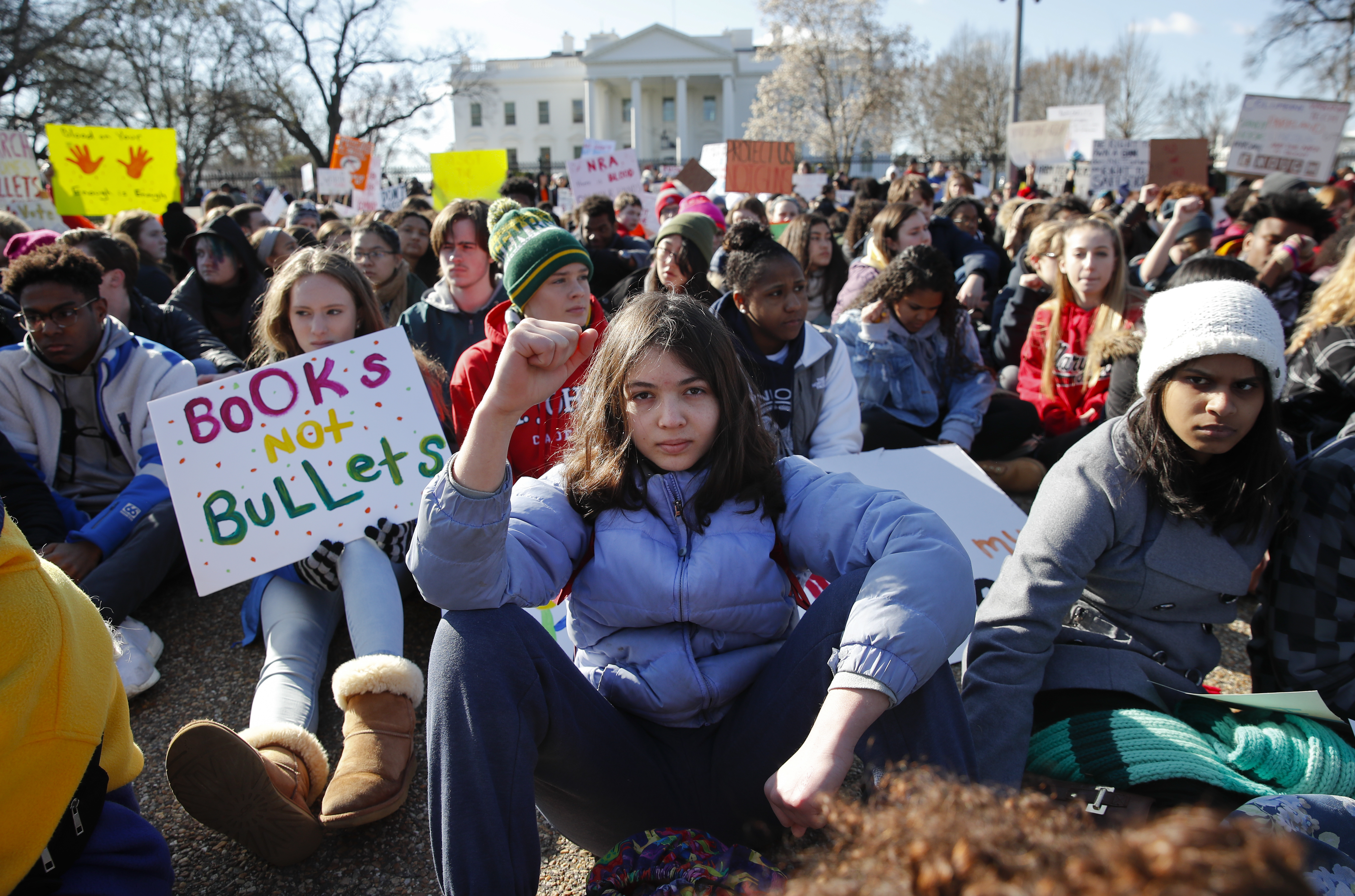Young people are cleverly using imagery to change the conversation on gun violence
This is solidarity on display


On Wednesday, students at nearly 3,000 schools walked out of their classrooms for 17 minutes in honor of the 17 people murdered at Marjory Stoneman Douglas High School one month ago. They used the occasion to demand change in a variety of ways and on a variety of platforms. If it was a stunning demonstration of political outrage, it was also, more crucially, proof of a form of generational solidarity we haven't seen in some time. There's a lot these events can teach us about what digital natives can achieve when local activism hooks up with decentralized platforms like Twitter. There might even be some hints here about what the leadership of the future will look like.
The first startling fact is that, unlike every previous outrage cycle over gun violence after a mass shooting, these protests aren't diminishing. In fact, they're growing. They're adapting to include a long and painful history of record-breaking mass shootings, from Columbine to Sandy Hook. And they're adapting to include the less sensational but more pervasive effects of everyday gun violence as well.
"Black Lives Matter has been advocating for gun control for years," one student in Idaho said. "If teachers were to have guns in the classroom, we and other students of color would be more likely to be victims of violence." Some 600 students in Atlanta elected to take a knee to protest gun violence in solidarity with Colin Kaepernick's protest against the rash of unarmed black citizens killed by police. Students at North Lawndale College Prep in Chicago marched with red tape over their mouths and carried crosses with photos of murdered loved ones to call attention to how they're asked to silently endure everyday gun violence. It's stunningly effective. Students at Excel Academy in Baltimore commemorated not just the 17 students murdered at Parkland but also the seven students they've lost to gun violence in one year — and other Baltimore victims like Freddie Gray and Korryn Gaines. "As a black boy, I hope that one day I have as many rights as a gun," read one young man's poster.
The Week
Escape your echo chamber. Get the facts behind the news, plus analysis from multiple perspectives.

Sign up for The Week's Free Newsletters
From our morning news briefing to a weekly Good News Newsletter, get the best of The Week delivered directly to your inbox.
From our morning news briefing to a weekly Good News Newsletter, get the best of The Week delivered directly to your inbox.
More recent tragedies, like the murder of Courtlin Arrington, a student shot at her school, were remembered, too. So were older ones: It's startling to watch a shooting survivor like Cameron Kasky, one of the Marjory Stoneman Douglas students, tweet in support of students marching at Columbine, where this all began before he was even born. So is the sight of hundreds of students solemnly marching out of school in Newtown, where 26 people lost their lives in 2012.
I realized, watching these stories of trauma intersecting through images and social media, that there have been so many shootings at this point that once-isolated tragic communities — shaped by exceptional trauma and loss — are becoming a constituency. These grieving kids and parents and communities are finding each other. It's a bittersweet communion to witness. It's sobering to watch history coalesce into a cause. We may be watching the political formation of what's being called Generation Columbine: a group shaped by the deforming effects of mass shootings and American policies that enable them.
The real "Generation Columbine" — students in 1999 — couldn't do much to protest gun violence because there was no way to get that message out. Today's kids can: They're digital natives, and students across the country are learning to protest for publics they can't necessarily see. Take the overhead spectacles, like these in Florida, or Zurich, or Los Angeles, or Nashville.
These are specifically meant to be seen from a viewpoint inaccessible to the students on the ground, and that's telling: If school protests used to feel like wasted energy, social media has made other audiences possible. The result is a mixture of local engagement and public messaging: Cooper City High School had empty desks and podiums to commemorate the 17 dead. There were die-ins all over the country. Students packed four floors of the Idaho statehouse. Seven-thousand pairs of shoes were left on the lawn of the Capitol, one for every child killed by a gun since Sandy Hook. This is powerful image-making for multiple publics.
A free daily email with the biggest news stories of the day – and the best features from TheWeek.com
Image-making creates its own problems. There were also trolls, of course, and they were dealt with. That's part of spectacles like this too. But more interesting were the peculiar (and instantly viral) images of students who were the "only ones" to walk out of their schools, like second-grader Leonardo Aguilar and high schooler Justin Blackman, who posted a video of himself on an otherwise empty campus.
And those who tried to stop images from getting out didn't do it very well. Some schools, like Covina High, did their best to minimize the impact of the student protests by frustrating media coverage. Students at Mt. Diablo High broke through a gate locked by staff before the 10 a.m. protest — creating one of the more dynamic photos of the walkout.
As for the students of Marjorie Stoneman Douglas, many kept a relatively low profile during this event, but they were on hand to magnify complaints by students across the country who were suspended or punished for taking part. Other public figures did much the same; as a result, the steps schools took to try to stop the students are quite visible, from detentions to tests scheduled during the protest to oddly timed tornado drills and allegations of corporal punishment.
This is fascinating stuff. We're watching protest, the policing of protest, and dialogue between protesters evolve under the very system that democratized broadcasting. And these kids are extraordinarily fast learners.
I said at the beginning of this piece that we might be getting some hints of what shape the leadership of the future might take. Look: This is a bleak moment. We're currently surviving the worst excesses of what baby boomers thought leadership meant: It is blustery, frenetic, narcissistic, proudly ignorant, and totally lacking in ideals. It is white and male, and it believes only in intimidation and dominance — and frames everything in those infantile, malevolent terms.
My jaw dropped, therefore, when I saw this photograph:
[AP photo/Carolyn Kaster]
I can't say enough about this photo; this is brilliant composition, the kind that creates icons. I love the handprints on the yellow sign in the background, the friendly, almost bubbly lettering of the "Books not Bullets" sign on the left. But the juxtaposition of that aesthetic with that central figure's raised fist? That's expressing something profound, maybe even transformative. The White House founders into near-irrelevance in the background; it seems singed by the scorching glare of the figure on the right and muted by the range of Americans sitting in front it demanding to be heard. And the more I zoom in on that central figure's expression, the more naively hopeful I become. There's immense strength on display there. If we can learn to see true leadership in the confident power of that stare, the crumples of that puffy jacket, the massive, intelligent presence of those eyes; if we can articulate whatever fierce hope resides between "Books not Bullets" and that fist casually dominating the foreground ... well, there might be hope for us.
There is for them.
Lili Loofbourow is the culture critic at TheWeek.com. She's also a special correspondent for the Los Angeles Review of Books and an editor for Beyond Criticism, a Bloomsbury Academic series dedicated to formally experimental criticism. Her writing has appeared in a variety of venues including The Guardian, Salon, The New York Times Magazine, The New Republic, and Slate.
-
 Farage’s £9m windfall: will it smooth his path to power?
Farage’s £9m windfall: will it smooth his path to power?In Depth The record donation has come amidst rumours of collaboration with the Conservatives and allegations of racism in Farage's school days
-
 The issue dividing Israel: ultra-Orthodox draft dodgers
The issue dividing Israel: ultra-Orthodox draft dodgersIn the Spotlight A new bill has solidified the community’s ‘draft evasion’ stance, with this issue becoming the country’s ‘greatest internal security threat’
-
 Codeword: December 13, 2025
Codeword: December 13, 2025The daily codeword puzzle from The Week
-
 Has Zohran Mamdani shown the Democrats how to win again?
Has Zohran Mamdani shown the Democrats how to win again?Today’s Big Question New York City mayoral election touted as victory for left-wing populists but moderate centrist wins elsewhere present more complex path for Democratic Party
-
 Millions turn out for anti-Trump ‘No Kings’ rallies
Millions turn out for anti-Trump ‘No Kings’ ralliesSpeed Read An estimated 7 million people participated, 2 million more than at the first ‘No Kings’ protest in June
-
 Ghislaine Maxwell: angling for a Trump pardon
Ghislaine Maxwell: angling for a Trump pardonTalking Point Convicted sex trafficker's testimony could shed new light on president's links to Jeffrey Epstein
-
 The last words and final moments of 40 presidents
The last words and final moments of 40 presidentsThe Explainer Some are eloquent quotes worthy of the holders of the highest office in the nation, and others... aren't
-
 The JFK files: the truth at last?
The JFK files: the truth at last?In The Spotlight More than 64,000 previously classified documents relating the 1963 assassination of John F. Kennedy have been released by the Trump administration
-
 'Seriously, not literally': how should the world take Donald Trump?
'Seriously, not literally': how should the world take Donald Trump?Today's big question White House rhetoric and reality look likely to become increasingly blurred
-
 Will Trump's 'madman' strategy pay off?
Will Trump's 'madman' strategy pay off?Today's Big Question Incoming US president likes to seem unpredictable but, this time round, world leaders could be wise to his playbook
-
 Democrats vs. Republicans: who are US billionaires backing?
Democrats vs. Republicans: who are US billionaires backing?The Explainer Younger tech titans join 'boys' club throwing money and support' behind President Trump, while older plutocrats quietly rebuke new administration
